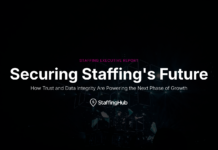
By Andre Mileti, product evangelist for talent experience at Bullhorn
I was recently in the market for someone (or something) to manage my retirement savings. I didn’t know what to expect from the service, but I knew what to expect from the experience of choosing the right partner. As consumers enabled by technology in all shapes and forms, we’ve come to expect a certain level of control through a buying journey. Whether buying a home or laundry detergent, procuring a handyman to fix a gutter, or in my case, finding someone to deal with my investment portfolio, a shared understanding of best practices has emerged in our modern, consumer-driven society.
My process began with a conversation with a peer, someone I trusted who does more research than Nielsen and has been smart with money her whole life: my sister.
“You have to try this free online platform — it connects all your accounts, and you’ll get a financial dashboard instantly,” she told me. “Then you can use their self-service tools to budget and build a retirement plan, and they have managed services, too!”
So I did. I created a profile, and in a matter of minutes I had my entire financial world in focus and on one page, complete with visually appealing charts and graphs, telling me I need to save more money.
I received a welcome email (generic) when I signed up, but then a personal email (probably automated, but it felt personal) from a financial advisor (let’s call him Josh) who offered a free financial assessment. I bit. I was able to access his calendar from the email and had a 30-minute meeting on the books for the next day. The call went great. We actually ended up needing another call, which I was able to schedule before I hung up. A prompt calendar invite followed. The second meeting was as productive as the first. An email followed up asking me how my experience has been so far. One click was all I had to do to deliver a five-star rating.
Within 72 hours I felt I had made a decision, without really making one or looking elsewhere. The experience was guiding me.
Then I realized I knew nothing about this company, other than they had a slick online tool, Josh seemed very smart, and my sister recommended them. Now that I think about it, she’s horrible at making decisions! I needed to hit up Google to launch my own investigation.
Positive reviews and personal testimonials flooded my screen. Unbiased reports of benefits and drawbacks were bountiful. I felt at ease, and looked forward to my next conversation with Josh, who also had his own positive recommendations.
The experience was everything I had expected and more. It was omni-channel, with a combination of word of mouth, experiential (self-service), web, app, email, phone calls, and reviews. All the touchpoints were timely and relevant. I felt in control the entire time. When I wanted information, I had it at my fingertips. When I was looking for value, it was there — before I even committed. I was educated, motivated, and inspired by the path laid out before me.
Years ago this experience did not exist. My only option was to sit down with a local advisor whom I vetted through a few friends and family. I didn’t have many choices. The level of effort to go through the process was substantial.
The financial sector, like travel and retail before it, started embracing this type of digital transformation and acute focus on customer experience years ago. Driven by advancements in technology, organizations have designed new methods of delivering value, tailored for the customer and designed by this change in what is expected. The balance of power has shifted to the customer, and businesses have re-invented themselves to stay relevant and survive.
Now, work, too, has become commoditized (especially for younger generations). Enjoying a consumer-grade experience throughout the entire hiring journey has become just as important as the work itself. Talent abandon job applications and interviews at the same rate they abandon online shopping carts in search of a better deal or faster shipping. They apply to numerous jobs in the time it took earlier generations to find and apply to one.
If you don’t invest in a mix of modern digital marketing, recruitment, and user experience best practices, you’ll have a hard time attracting, engaging, and retaining digitally native talent. If the job application process is not as easy as scrolling through Instagram, you will lose. Simply taking antiquated methods of hiring and placing talent and bringing them online will not suffice. New business processes and technologies focused on talent experience and automation must be forged.
If I were in Josh’s database and he had sent me a spammy email offering free financial advice, I would not have bitten. If Josh’s strategy was to “cold connect” with me via LinkedIn, I would have hit the rejection button. Same service, same outcome eventually, but the experience did not jive with what I value first and foremost as a consumer.
I wouldn’t be alone. Findings from Bullhorn’s recent GRID Talent Trends Report show that 66% of temp talent have abandoned an application or hiring process because of a negative experience. In addition, 23% of temp talent are choosing to work with a staffing firm based on reputation alone. And once they start working together, 60% of talent are expecting recruiters to reach out once a week with relevant opportunities.
This is the “consumerization of employment,” as I like to call it, and it started taking hold of the staffing and recruiting industry well before the pandemic and the more recent labor shortage figures. It began when talent found new ways to work through the gig economy. Simultaneously, as younger generations entered the workforce, the value system of work changed. Younger workers began valuing flexibility and experience over pay rate and stability — something that older generations chasing the American dream never imagined.
Staffing and recruiting firms are at a crossroads. Become Netflix or become Blockbuster. Look beyond the tools and processes designed for traditional channels. Put yourself in your talent’s shoes, understand what they value, and design hiring and employment experiences that drive conversion and retention. Then iterate on it to improve the results. In some cases, these efforts may require replatforming, investments in new technology, or hiring internal talent who think more like digital marketers. The good news is that our predecessors (the travel, finance, and retail industries) have left us with blueprints on how to not only survive, but thrive in this new world of work where employment is commoditized, but experience and value reign. This is why, at Bullhorn, we have developed the Connected Recruiting strategy. We aim to educate the industry on how to turn the talent lifecycle into a flywheel, and how a focus on experience and engagement can turn a talent pool into a talent community.
Regardless of the technology suite you invest in, at every stage of the talent lifecycle, at every touchpoint or moment that matters, you must become obsessed with talent experience and conversion, the same way I was hooked by Josh and his company. The experience I had was no accident. It was curated by a cross-functional team whose goal was to deliver an unparalleled customer experience. And as we speak, I am sure they are measuring their outcomes and making modifications to the channels, touchpoints, or content they use in an effort to improve conversion or reduce customer acquisition time.
 Andre Mileti is the product evangelist for talent experience at Bullhorn. Mileti joined Bullhorn at the beginning of 2022 with the acquisition of Able, where he was a founding member and led all go-to-market and sales efforts. Prior to his foray into the staffing industry, Mileti spent over a decade in eCommerce where he helped the world’s largest and most innovative brands/retailers design marketing and merchandising experiences focused on improving online conversion.
Andre Mileti is the product evangelist for talent experience at Bullhorn. Mileti joined Bullhorn at the beginning of 2022 with the acquisition of Able, where he was a founding member and led all go-to-market and sales efforts. Prior to his foray into the staffing industry, Mileti spent over a decade in eCommerce where he helped the world’s largest and most innovative brands/retailers design marketing and merchandising experiences focused on improving online conversion.






